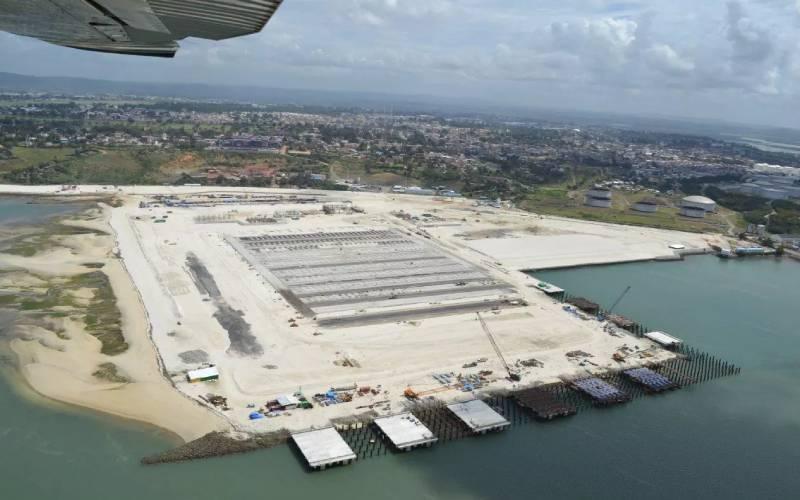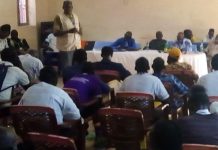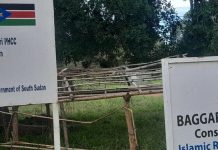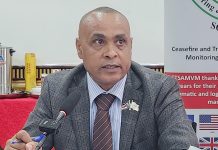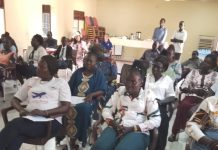Africa-Press – South-Sudan. On July 2011, South Sudan became the youngest nation not just in the African continent but in the world that to a 2005 Comprehensive Peace Agreement (CPA) that set in motion to independence from Sudan.
South Sudan is a landlocked country and despite the promise of oil revenues, she needed to embark on strategic infrastructure, as well as seek regional integration through trade blocs, some of which she had joined.
On March 2, 2012, less than a year after independence, South Sudan President Salva Kiir was in Mokowe-Lamu on the Indian Ocean coast of Kenya. He was not alone. Also present was the host President Mwai Kibaki and Ethiopian Prime Minister Meles Zenawi. The respective regional leaders were gathered here to jointly launch the Lamu Port -South Sudan-Ethiopia (LAPSSET) project.
Dubbed the most ambitious infrastructural undertaking on the continent, at an estimated cost of some $25bn though its importance as vital transport and economic development corridor for the region is seen to surpass its exorbitant cost.
LAPSSET was envisaged as a bridge that will link the Indian Ocean side of the continent to the Atlantic coast and in the north, it links into the Northern Corridor into Djibouti, Sudan and Egypt.
The LAPSSET Corridor is arguably one of the regional infrastructure projects that is important to South Sudan and to which it belongs (LAPSSET).
The project connects 160 million people in the three countries. The Corridor is also part of a wider land bridge that would connect Lamu Port on the East African coast to Douala Port on the West African coast through South Sudan.
Kenya has completed the first face of Lamu Port and has begun docking containers TO destinations such as Ethiopia.
Kenya has set aside land at the port for traders from Ethiopia and South Sudan to store and sell their wares.
It is now up to traders in the two-member states to take advantage of the opportunity and begin exchanging their commodities to reap the benefits of the infrastructural initiative.
South Sudan agreed to construct a highway from Nadapal to the Kenyan border down to Juba, as well as an oil pipeline and a standard gauge railway that would connect East Africa to West Africa.
However, officials in South Sudan demonstrated a renewed commitment to the project’s implementation during their interactions with the LAPSSET team, which visited the country last week to assess the project’s progress and lay the groundwork for the third Ministerial Meeting, which will be held in Juba.
UNECA will assist the government of South Sudan in integrating LAPSSET into the national development plan 2040 so that it can be budgeted for and monitored, according to team leader Adeyinka Adeyemi, senior advisor of African Trade at the United Nations Economic Commission for Africa.
Madut Biar Yel, South Sudan’s Minister of Transport, who characterized the project as “extremely positive” for the country’s economy, said the government is dedicated to speeding up the implementation process and will send a construction company to Nadapal to pick up where the Kenyan government left off.
“We have a lot of potentials that we need to share with our African brothers and sisters, and this will be part of the LAPSSET implementation because we have a lot of resources within Africa that we need to develop to improve the lives of our people,” said Biar.
In addition, South Sudan’s ministry of trade and industry told the LAPSSET team that they’ve identified six products that may be developed for export and are working on a national export and investment policy to steer trade.
LAPSSET outline
This mega project consists of seven key infrastructure projects starting with a new 32 Berth port, Crude Oil Pipeline, Oil Pipeline, an interregional Standard Gauge Railway lines from Lamu to Isiolo, Isiolo to Juba, Isiolo to Addis Ababa, and Nairobi to Isiolo; three International Airports (one each at Lamu, Isiolo, and Lake Turkana) three Resort Cities (one each at Lamu, Isiolo and Lake Turkana); and The multipurpose High Grand Falls Dam along the Tana River.
The regional corridors are positioned to boost continental economic growth by enhancing intra-African commerce and reducing high-risk transit procedures without incurring additional costs.
When finished, the transport route that South Sudan and Ethiopia conceived after Kenya will reduce South Sudan’s reliance on the port Mombasa for commodities transport through Uganda, which takes days and are costly.
The LAPSSET Corridor is designed to function as an Economic Corridor, giving numerous Eastern African countries access to a large-scale economic trading system and supporting regional socio-economic growth.
It is composed of two components: a 500-meter-wide Infrastructure Corridor that will carry road, railway, pipelines, power transmission, and other projects, and a 50-kilometre-long Economic Corridor on either side of the Infrastructure Corridor that will house industrial investments.
The Program has seven important infrastructure project components in Kenya. The Kenyan government developed a budget estimate of US$24.5 billion for project implementation, which is equivalent to Kshs. 2.4 trillion at current exchange rates in construction costs.
Lamu Port, with its 32 berths, is expected to cost US$ 3.1 billion, the Railway US$ 7.1 billion, and the crude oil pipeline US$ 3 billion for the Lamu to Lokichar trunk line alone.
Cross-border trade
The restoration of peace led to a significant demand expansion in South Sudan. The oil windfall, which was driven by the new flow of oil revenue to the Government of South Sudan (GoSS) based on the wealth-sharing agreement between the North and the South, coupled with foreign aid, allowed a large increase in public expenditure in the South.
The demand growth in South Sudan together with the lack of local production capacity then led to a sharp increase in cross-border trade between Sudan and Uganda. But multiple reports show that the bilateral trade between Uganda and South Sudan is highly asymmetric with the volume of exports from Uganda being disproportionately larger than the volume of exports from Sudan to Uganda and largely informal. South Sudanese exports to Uganda are negligible compared to Ugandan exports to Sudan.
The leading exports, both formal and informal, from Uganda to South Sudan include food and other consumer non-durables and construction materials. A range of products are exported from Uganda to Sudan with food (e.g., beer, water, food products, sugar, cooking oil) and construction materials (e.g., cement, iron sheets) being the leading exports.
While South Sudan used to export a range of products such as cow, hides and skin, honey, coffee beans, groundnuts, sesame, beans, horn and hoofs, and gum arabic, the only product currently exported is timber. Based on the survey data, the major informal unrecorded exports from Uganda to South Sudan are similar to those in recorded formal exports.
For both Oraba-Kaya and Bibia-Nimule border posts, two principal posts along the Sudan-Uganda border, crops and industrial products have significant shares in the total informally exported products from Uganda to South Sudan.
The distance from Mombasa port to Juba via Uganda is 1,619 kilometres, and the distance from Lamu port to Juba is 1,304 kilometres, with a five-hour drive from Nakodok, a Kenyan border settlement, to Juba, which means the completion of LAPSSET project will complicate the cross-border trade between South Sudan and Uganda.
“This is another opportunity which opens to our traders, our people, and our transporters as an alternative,” says Lado Togon, Director General of Transport and Road Safety who visited the LAPSSET project site at the port of Lamu previously said. “The project is now a reality and we should now hurry up to do our part to make this project useful and operational to South Sudan because every country now is doing its obligation and am sure my government will do its obligation because it is not that we have not started. We have started.”
In comparison to port Mombasa, Lamu port now provides another alternative shipping route for goods and services that cross only one border point cheaply and quickly to South Sudan.
Regional integration assists countries in overcoming barriers to the free flow of products, services, capital, people, and ideas. Economic progress is hampered by these divisions, particularly in emerging countries.
Economic growth is hampered by inefficient infrastructure and policies. Regional integration allows governments to overcome these costly barriers by integrating commodities, services, and factor markets, allowing commerce, capital, energy, people, and ideas to flow more freely.
Common physical and institutional infrastructure can help to promote regional integration. Regional integration, in particular, necessitates cross-country collaboration in trade, investment, and domestic regulation, transportation, ICT and energy infrastructure, macroeconomic and financial policy, and the provision of other common public goods.
Cooperation in these domains takes various institutional forms, has varying levels of policy commitments and shared sovereignty, and is prioritized differently in different regions.
Regional integration can result in significant economic gains by allowing countries to improve market efficiency, share the costs of public goods or massive infrastructure projects, collaborate on policy decisions, and provide a foundation for reform. As well as reaping non-economic rewards like peace and security.
The LAPSSET project has resulted in indirect employment for over 1600 people in current and completed projects and has provided local inhabitants with long-term employment while also allowing skill transfer in Kenya.
The project has helped over 350 students pursue technical and professional training in Kenya and has a lot of investment opportunities that would increase employment among youths and promote business along highways to the port of Lamu.
The idea was conceptualized in 1975 but never saw the light of day due to a variety of factors. Later, the project was re-launched and incorporated into Kenya’s Vision 2030 framework.
Parts of the project have been completed by Kenya and Ethiopia, mainly the road network connecting the member states. However, South Sudan continues to lag.
The LAPSSET Corridor Project is the newest project to be included in the Presidential Infrastructure Championship Initiative (PICI) list. It was approved as a PICI project during the African Union (AU) Heads of State and Government Orientation Committee (HSGOC) meeting in Johannesburg, South Africa, in June 2015.
The PICI’s acceptance of the LAPSSET Corridor Project grants it continental institutional and leadership approval and recognition, which boosts investor confidence in the project. The LAPSSET Corridor Program now has a higher priority in the government’s development agenda as well as regional and continental infrastructure investment plans.
The LAPSSET Corridor Project has also been accepted as an African Union PIDA Project (Program for Infrastructure Development in Africa). This advancement allows the project to be prioritized for support at the continental level through AUC/NEPAD for project planning and implementation funds.
For More News And Analysis About South-Sudan Follow Africa-Press

